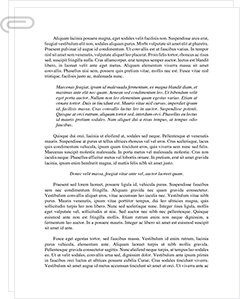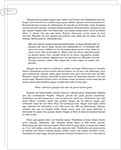 Study Document
Study Document
Health Care Administration Term Paper
Pages:3 (857 words)
Sources:3
Subject:Health
Topic:Critical Care Nursing
Document Type:Term Paper
Document:#24667658
Nursing -- Health Care Administration and Leadership
The modern clinical health care environment can be highly stressful for employees and lead to various types of conflicts in the workplace. Within nursing, those conflicts typically manifest themselves as abuse of authority as between different levels of authority, a hostile climate with respect to reporting problems, scheduling preferences, and numerous problems associated with social cliques within health care teams and nursing units. If not addressed by administration, power struggles often develop, requiring negotiation and conflict management after the fact. In general, the conflict management strategies of avoidance, accommodation, smoothing, and competing are not particularly helpful. Instead, administrative policies emphasizing negotiation and collaboration is the most appropriate conflict management approach within nursing units and the enforcement of clear administrative policies and protocols are the most effective method of minimizing conflict as between different hierarchical levels of authority.
Negotiation and Conflict Management in the Health Care Setting
At the nursing unit level, the principal sources of interpersonal conflict are personality differences, group allegiances, social exclusion, and competition for preferred schedules and shifts (Marquis & Huston, 2008). None of those types of conflict is amenable to avoidance, accommodation, smoothing, or competition; all of those approaches to conflict resolution are more likely to perpetuate and exacerbate the underlying problems and magnify the interpersonal conflicts emerging from them. Instead, health care institutions and administrators must set and enforce strict policies designed to minimize the development of interpersonal conflict capable of compromising the quality and safety of health care by undermining the effectiveness of nursing units (Marquis & Huston, 2008).
Negotiation and conflict resolution at the nursing unit level should emphasize administrative fairness and institutional expectations of mutual support and professional collaboration among coworkers (Rosengren, Bondas, Nordholm, et al., 2010). In principle, that requires addressing the typical sources of interpersonal conflict in advance, before they actually occur, and outlining the expectations of supervisors and administrators. A carrot-and-stick approach in that regard would involve establishing an institutional culture in which nursing units receive conflict awareness and avoidance training in connection with a zero-tolerance perspective on the part of administrators.
That would include addressing inappropriate social exclusion and the expectation of any unofficial privileges or latitude associated with seniority beyond those actually established and recognized by the institutional administration. Negative behaviors that undermine the effectiveness of teams should trigger intervention and positive behaviors in the area of collaboration should trigger recognition and reward. Therefore, at the nursing unit (or working group) level, the encouragement of collaboration and the discouragement of conflict-generating behaviors in relation to the typical causes…
Sample Source(s) Used
References
Kelly, M. "Change from an office-based to a walk-around handover system." Nurse
Times, Vol. 101, No. 10; (2005): 34-35.
Marquis, B.L. And Huston, C.J. (2008). Leadership Roles and Management Functions in Nursing: Theory and Application. (6th ed.). Philadelphia: Lippincott, Williams, & Wilkins.
Rosengren, K., Bondas, T., Nordholm, L., and Nordstrom, G. "Nurses' views of shared leadership in ICU: A case study." Intensive and Critical Care Nursing, Vol. 26,
Related Documents
 Study Document
Study Document
Healthcare Administration
Healthcare Administration: Healthcare Law, Cultural Diversity, And Principles of Accounting Cities, Suburbs, And Rural Areas Rural areas are geographic areas located away from suburbs and cities, often characterized by a small population and abundant natural resources. Currently, in the U.S., rural residents make up 16% of the entire population - as compared to 17% in 1910. This implies that poor job opportunities and lack of skills that are evident in these areas
 Study Document
Study Document
Healthcare Administration
Healthcare Administration The family is the earliest source of an individual's moral beliefs and principles (Dunn & Woodard, 2003). Essentially, children are not born with a set of moral principles -- they acquire a sense of what is wrong/right by observing how others react to their behavior. As a child, for instance, I was forbidden, right from my formative years, from taking something that belonged to someone else without their consent.
 Study Document
Study Document
Healthcare Administration in a Perfectly Competitive Market,
Healthcare Administration In a perfectly competitive market, the following will occur in response to different changes in the market. A decrease in the wage of clinic-based nurses will cause a reduction in the cost for nurses. This will result in a decline in the price of physician services, because the price decrease is going to be passed onto the consumer. The output of physician services will not change as the cost declines,
 Study Document
Study Document
Healthcare Administration and Leadership Health Care in
Healthcare Administration and Leadership Health care in the United States has progressed and improved to the point at which providers in all health care settings have defined and developed at least 4 major areas of importance for effective health care. Knowledgeable health care leaders have identified Quality and Safety; Community Health; Health Care Access and Coverage; and Leadership and Governance as key areas that must be constantly addressed and improved to
 Study Document
Study Document
Healthcare Administration the Six Stakeholders Groups for
Healthcare Administration THE SIX STAKEHOLDERS GROUPS FOR RIVERVIEW REGIONAL MEDICAL The six stakeholder groups for the Riverview Regional Medical Center are as follows: clerical staff, medical laboratory technicians, nurses, housekeeping staff, patients, and physicians. The hospital is comprised of 700 people who all play as stakeholders for the hospital. TARGETS MARKET OF EXISTING PROGRAMS AND THE GAPS IN RRMC MARKETING STRATEGY An addition added to the RRMC is the Heartburn Treatment Center. A nurse
 Study Document
Study Document
Healthcare Administration Functions of Healthcare
Administrative boards routinely reevaluate general institutional compliance with federal and state legislative statutes and also with stated hospital policies. Ethics guidelines regarding procedures, treating minors, and admission to clinical research trials are only some of the legislative guidelines necessary when making healthcare decisions. Chains of command, appropriate disciplinary and appeals procedures, and health and safety guidelines for patients and employees are some examples of legislative functions a board may



